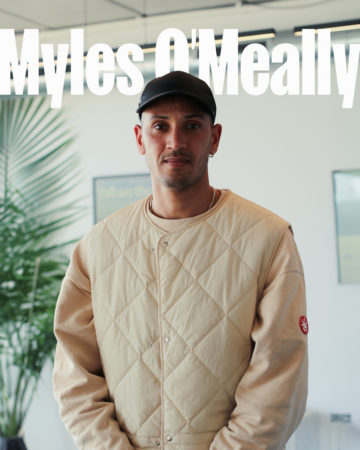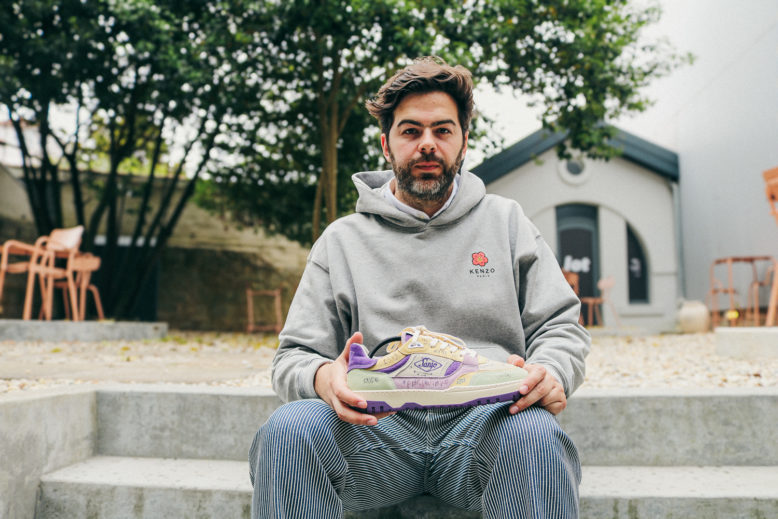
For our first interview in Portugal, in the city of Porto, we spoke with Vitor Costa, who has been working in the footwear industry for ten years, and today is the creative director and head of product and design at Sanjo, a Portuguese footwear brand with 90 years of history, that brings today modern, tasteful and very high quality sneakers. Within the brand he has a 360º role, where he takes care of the brand’s creative vision, image, fashion editorials and the brand’s language. He talked about the importance of the brand’s narrative and how Sanjo is innovating Portuguese culture.
For his interview, he highlighted the BSK 33, a sneaker that carries much of the brand’s essence and tradition, and brings very high quality materials in an impeccable execution. If you are looking for a truly unique and special sneaker in Portugal, be sure to check out Sanjo’s sneakers.
“My name is Vitor Costa and I’ve been working in the footwear industry for ten years. I studied fashion design and also graphic design, but what really got my attention were sneakers, mostly because they’ve always surrounded me through the things that I liked. In the beginning, it was that thing that you would see in music videos or in fashion.
I took a very technical course in footwear at the Design Academy and I always tried to go after sneakers. Early on I worked for a brand that produced boots. I even tried to continue in this category, but it didn’t flow so well. And then came Sanjo at the right time – I was starting to work as a freelancer and to do projects with some brands.
Today at Sanjo I do a 360º coverage of the brand, I control the brand image and all the creative parts, up to fashion editorial. That gives my work a lot more strength, because what I deliver has more harmony. I think it’s easy for someone with a design background to deliver a good product, but to have this kind of consistency in creating collections and having them in harmony in the same space, with the same visual language, is much more difficult.”


Portugal is very big in the footwear and clothing industry. How do you think the country shaped you as a creative?
vitor I lived relatively close to the factories, even though my family did not work in either the footwear or fashion industry. I grew up seeing things happening very closely, in my friends’ factories. I always say that Portugal could be a breeding ground for sneaker culture.
I remember that in 2000, there were premium sneaker brands, like Filling Pieces, which were produced in Portugal. It also produced Dutch brands and I wondered: how is it that so many Dutch brands, such a small country that doesn’t have a solid sneaker culture like in the United States, gets to do so much cool stuff? This, for me, is the gap between the European countries that produce here, and Portugal.
“I lived relatively close to the factories, even though my family did not work in either the footwear or fashion industry. I grew up seeing things happening very closely, in my friends’ factories. I always say that Portugal could be a breeding ground for sneaker culture.”



How did you become interested in design and how did you enter this creative universe?
vitor A few years ago, I remember going to a Mind the Gap concert, a hip-hop trio here from the north of the country. I still had no connection with hip-hop, I was a teenager, I felt that I still had no identity. But I remember just looking at the band, the way they dressed, how they were using Air Force 1s and ACG boots, and that impacted me. That was a turning point.
Later on, the parties, graphic design, all that stimulated my mind. There are people who have always had a creative drive to draw, to make things. I have to say that all that came later for me. I understood what I wanted from this universe.

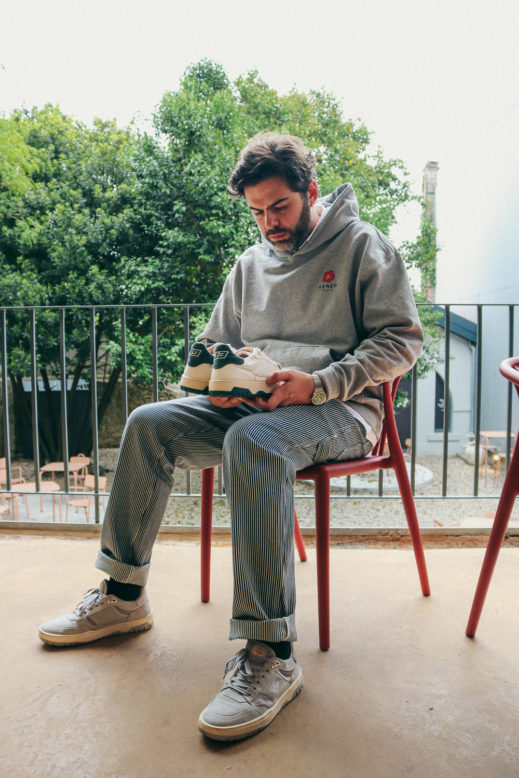
Do you remember when your passion for sneakers started? That moment when you see a pair and get that "click"?
vitor In the past there were not many casual, lifestyle sneakers, they were mostly performance. The first ones I remember were some Nike Uptempos and some Reeboks. I can’t remember which model, but I have a picture of me as a child with them on. And I particularly like this picture because I was wearing those sneakers. But when I really started to get in sneakers, around that time when Air Force 1s, Timberlands were very big. And later on when collaborations with luxury brands like Louis Vuitton, and Kanye West started happening. That moment when luxury brands started crossing over with sport and performance, that was a very cool moment.
And the interesting thing was that was the moment I felt that I should pursue a career in footwear. I was studying graphic design at the time, and a degree in sneaker design did not exist in Portugal, not even in Europe. I found a course in Italy but it was more focused on boots and classic shoes.
I remember that the shoe factories were quite “boring”, they only made black and brown shoes, in very large quantities. But with the first crisis, the premise began to change. We started to see smaller, more controlled, more sustainable production, with a lot more color options. It started to be more stimulating for me to be inside the factories, because in the beginning it was very difficult.
In my journey, I felt that I knew exactly what I wanted to do, what the assets were, and that I would have to wait for the right time. I couldn’t explore everything immediately, but I did what I believed in.
“I remember that the shoe factories were quite “boring”, they only made black and brown shoes, in very large quantities. But with the first crisis, the premise began to change. We started to see smaller, more controlled, more sustainable production, with a lot more color options. It started to be more stimulating for me to be inside the factories, because in the beginning it was very difficult.”

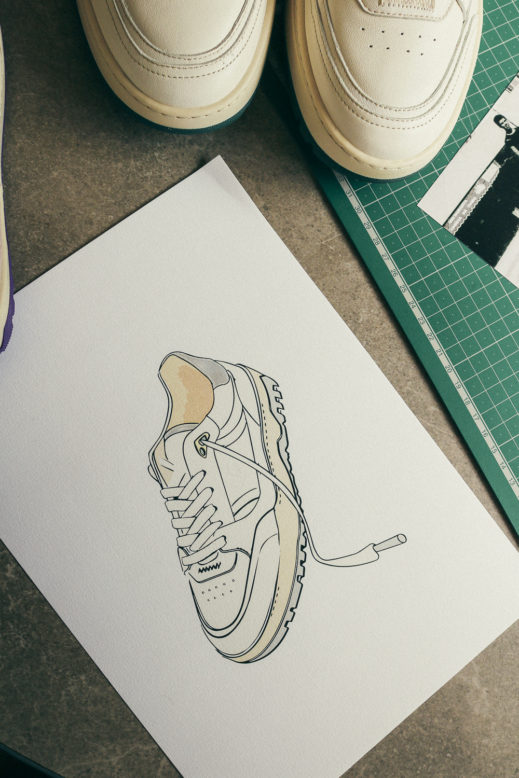
Tell us a little bit about Sanjo's history?
vitor Sanjo is a shoe brand that was founded in 1933. What attracted me most about the brand was that it had this true heritage, and not just something that was made up, or just something that existed just for the hype of the moment. It had heritage, a long history, it’s a 90 years old brand. In my view, Sanjo was very cool when it had protectionism from The New State (Estado Novo). We lived in a dictatorship, but from the moment Portugal became a democratic country, Sanjo went bankrupt.
It’s a big challenge for me to bring Sanjo back to Portugal. I often joke that Sanjo is a 90-year-old man who was treated really badly, but now is being well cared for again. I make this parallel a lot because it’s what I feel…and the challenge has been amazing because I can do what I believe in, which usually is not an easy thing to do.
“Sanjo is a shoe brand that was founded in 1933. What attracted me most about the brand was that it had this true heritage, and not just something that was made up, or just something that existed just for the hype of the moment. It had heritage, a long history, it’s a 90 years old brand. In my view, Sanjo was very cool when it had protectionism from The New State (Estado Novo). We lived in a dictatorship, but from the moment Portugal became a democratic country, Sanjo went bankrupt.”
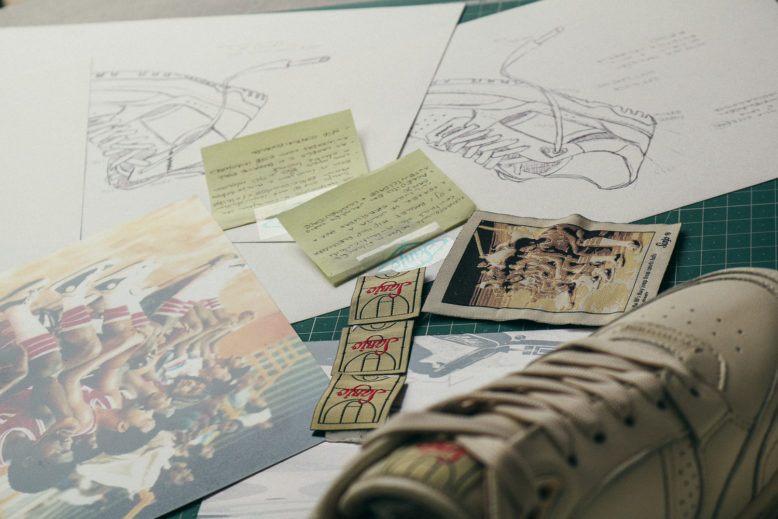


What is your role in the brand today?
vitor I work on all the creative parts, like fashion editorials and the brand’s language. For me, the narrative is the most important part of Sanjo and any brand. I like products, I like stores, I like to feel the pieces, but I think the narrative is very interesting. I brought the right assets to Sanjo, and I feel that it innovates Portuguese culture: you can see it in sports, and now you can start to see it in the music videos with the lifestyle category.
People saw Sanjo as an old brand, a “dad brand”, and we had a certain rejection from the younger audience. So we are modernizing the brand to change the way people see our brand and how the message within our products reaches our customers.
For example, some young people were already skateboarding in Sanjos, which was very curious. So we created a skate team, with the help of a magazine called Surge, which I say is the Portuguese version of Trasher. We paid for some trips, championships, and the skaters themselves challenged us to create a product for skating. This is how the sneaker Teste (test) came to be, which is exactly that. I didn’t want it to have the pretense of being a performance product, I wanted it to be a casual product that young people skated in, and at the same time I wanted to give those young skater on the team, the chance to get involved in the process of making the shoe, and to tell us how to improve the sneaker.
We did two brand activations, one in Porto and one in Lisbon, and it was incredible. I felt like everyone was there, that it was a real community – the Pros were there, the old dudes were there, the new kids, the junkies, we were able to have this convergence between the two sneakers and skateboarding. This new narrative is one of the most beautiful things I feel we brought to Sanjo.

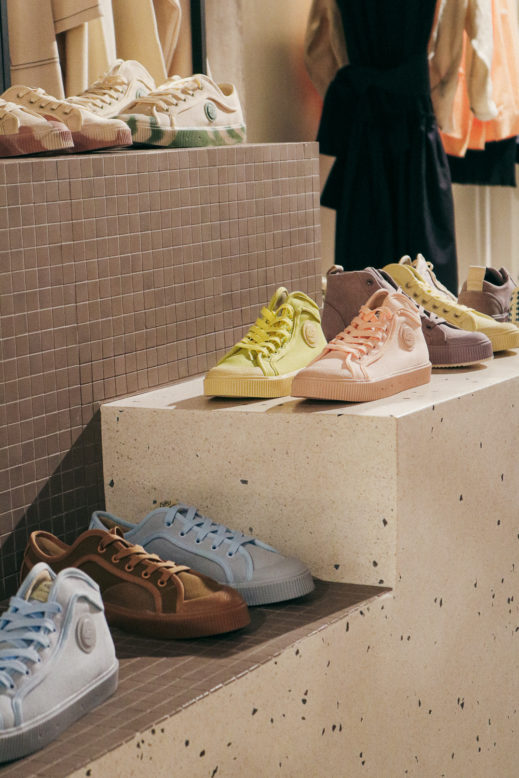
What do you see for the future of Sanjo?
vitor Sanjo is democratic. Unlike before, when everything was imposed, where you had to play football with this sneaker, you had to go to the army with that sneaker – there are countless photos of the national army wearing Sanjo. But I wanted it to be democratic, that people wanted to have and wear Sanjo. It’s not easy. And then, I want to make the brand global. I feel that in Portugal it is in the right channels, we have already done more than ten collaborations with fashion brands, with assets that I believe in: Alexandra Moura, PlayStation, La Paz, Wolf & Rita with our kids sneaker line, and many others.
Collaborating with people, brands and having a larger umbrella of products, protects us. I feel that Sanjo, despite being 90 years old, and you might think that it should be more of a conservative brand. Today it is playing this role in Portugal almost by itself. Sanjo has had this boldness since its inception.

Sanjo was also very present in basketball here in Portugal, right?
vitor Yes, we have some historical records. I’ve heard stories of Sanjo sneakers being exchanged for players in player transfers. And you could tell that Sanjo was proudly the official footwear of all the local clubs.
Deep down, I wish that the sneakers would cross over to the streets, to casual and lifestyle, I want to be in Berlin or Paris and see people wearing Sanjo. I’m already starting to see this in some cities, especially here in Lisbon and Porto, but I feel that Madrid and Barcelona are also growing and it’s amazing to see, and to be part of the whole process.
I feel that Sanjo, in the end, is in the spaces where it always was. In basketball, with a different creative approach, with a different kind of attention to it. At the time, they benefited from protectionism, they were the only ones around. But today there are so many options and it’s a huge pleasure for us, because people choose to have the sneakers, in a democratic way and not because it’s mandatory. I want people to wear Sanjo because they like it.
“I feel that Sanjo, in the end, is in the spaces where it always was. In basketball, with a different creative approach, with a different kind of attention to it. At the time, they benefited from protectionism, they were the only ones around. But today there are so many options and it’s a huge pleasure for us, because people choose to have the sneakers, in a democratic way and not because it’s mandatory. I want people to wear Sanjo because they like it.”


We hope to see Sanjo on the streets of Brazil too!
vitor Yes. I know quite a few people, who work especially in marketing, and they talk a lot about how having Sanjo in Brazil could work. We already have distributors in Israel, Italy, France and things naturally grow, at some point it will reach Brazil.
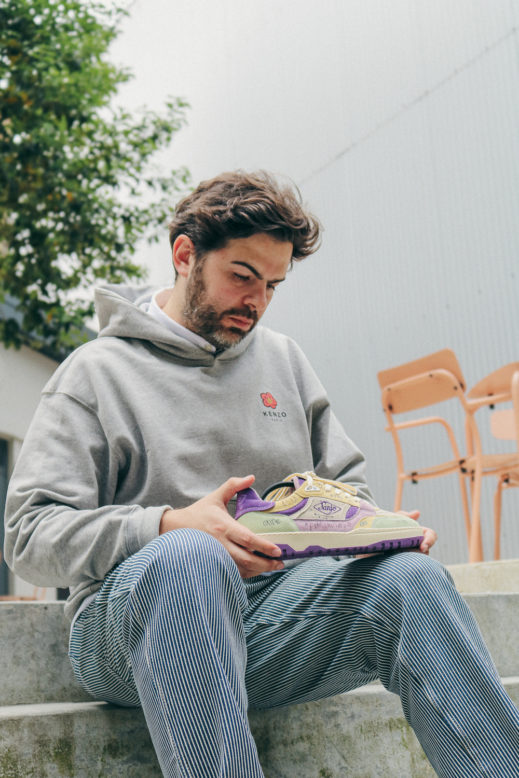

Why, of all the Sanjo models, did you choose to talk about the BSK33 for your Kickstory?
vitor I chose this sneaker because I feel it’s something new for Sanjo. It’s a more conservative model and at the same time contemporary within a capsule. This one, in terms of narrative, made the perfect match. We produced a very small, controlled amount of pairs at first, but then we had three more runs. We only sold in six stores, one of them is Latte, in Lisbon, which is a renowned store, and at 4Elementos, in Spain, which is also a renowned store.
About this sneaker here with all the notes scribbled on it, I really like this story. I really like suede, color blocking. I always try to match suede with other materials because it gives this vintage and contemporary feel to it, but also, I tried to use a soft leather. I want them to feel that it is a sneaker that came from the 70s and 80s, even though it’s a sneaker from 1933.
There are some things that I tried to bring to this pair. These four little holes I think nobody really knows, but they are present in all of Sanjo’s footwear. The box matches perfectly with this colorway, tha comes from the basketball universe. The details of the labels and tags, we brought everything from the archive. I also made a tag with this image from the 80s. The whole narrative is well tied up.

Sanjo BSK33 Low
Owner: Vitor Costa
Year: 2023
Photos: Kickstory


